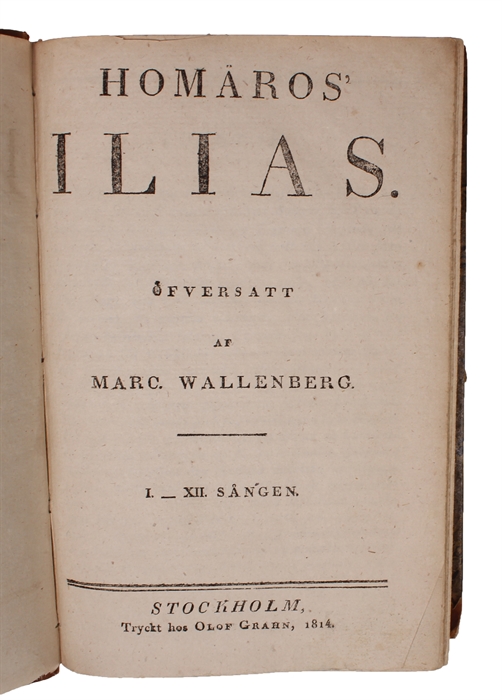FIRST COMPLETE SWEDISH EDITION OF THE ILIAD
HOMER.
Ilias. Öfversatt af Marc Wallenberg. I-XII. Sången + XIII-XXIV Sången. (I.e. fully complete).
Stockholm, Olof Grahn, 1814-15.
8vo. Bound in one lovely, contemporary brown half calf binding with gilt and blindstamped ornamentation to spine. A bit of wear to spine and extremities, but overall an excellent copy, also internally. The errata-leaf has been strengthened at the top, blank margin. Bound with both half-titles, which are not always present. (16), 303, (1); (4), 327, (1, - errata) pp.
Scarce first edition of the first complete Swedish translation of The Iliad, Marcus Wallenberg's famous magnum opus, which constitutes the first full Scandinavian translation of any Homeric work and which in many ways introduced Homer to the Swedish public. The work exercised great impact upon the reading public of Sweden and came to be highly influential. It was both highly praised and the source of much controversy, over metrics and translation-principles in general. "The first volume of Marcus Wallenberg's translation of the Iliad-which was going to be the first complete Swedish translation of the Homeric epics-appeared 1814… The reviewer in Stockholms Posten began by exclaiming "A Swedish translation of Homer in metric verse!!" He argued that the translation was a major achievement for Swedish literature and noteworthy for two reasons. Firstly, because of the source text. He describes Homer as the oldest and greatest poet in Greece and the world but says that he suspects that readers would be surprised by this description. This indicates that Homer was moving towards the top of the epic genre hierarchy and was overtaking Virgil, but that his position there was not quite uncontested yet. Secondly, because of the method of translating. The reviewer commends Wallenberg for choosing to make a faithful translation" (Goldwyn, edt.: "The Trojan Wars and the Making of the Modern World: Classical Reception Since Antiquity", p. 161). At the turn of the 19th century, as Swedish translators of the classics began to question the old conventions governing translation, the Iliad became a locus of aesthetic contestation, and Wallennberg's great achievement became the centre of attention. But the translation not only played a central part in academic descussions about Homer, the classics, and translation-principles, it paved the way for an understanding of the Homeric epics in Sweden and placed Homer among the canonical authors that had otherwise been neglected. "When the second volume of Wallenberg's Iliad appeared (1815), the whole Iliad was reviewed by Lorenzo Hammarsköld in Swensk Literatur-Tidning. Hammarsköld began by welcoming the translation and detailing the difficulties facing a Swedish translator of the Iliad, the main one being lack of interest and understanding for the Homeric epics among the Swedish readership. What Swedes of his time knew of Homer was, according to Hammarsköld, not much more than that Homer was sublime, majestic, and bold beyond description, but at times prosaic and unpolished, and that he, since he did not know of literary societies, could fall so far below epic grandeur, that he likened a king to a bull and a charming prince to a fly. Further, the Swedish public lacked in the education needed to properly appreciate the Homeric narrative and the beauty of his unaffected and unsentimental style. Therefore, Hammarsköld feared that "a translation in the genuine and grand style" would not be appreciated and that readers were likely to feel deceived, suspecting that a garrulous storyteller has been passed off as Homer and not know what to think of the translation at hand" (ibid. pp. 171-72) The translation did in fact prove to be very popular indeed and he gave to the general Swedish public the opportunity of reading one of the greatest world classics in their own language.
"Marcus Wallenberg, lecturer in Greek in Linköping gymnasium and later bishop in the diocese of Linköping, was the author of the first complete Swedish translation of the Iliad (1814-1815) and the Odyssey (1819-1821). The preface to the first volume of the Iliad gives readers to understand that Wallenberg had been observing the translations of Homer with great interest. These, he says, had made him hope that it would appear soon in a complete Swedish hexametric translation, a translation so faithful that it would preserve the spirit of the original and reproduce the effect of the Greek verse.48 When no Swedish Iliad appeared, he started working on a translation of that sort, even though he had no intention of publishing it." (ibid. p. 169)
Order-nr.: 59790


